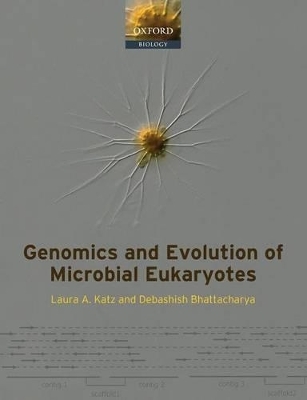
Genomics and Evolution of Microbial Eukaryotes
Oxford University Press (Verlag)
978-0-19-922905-5 (ISBN)
Genomics and Evolution of Eukaryotic Microbes synthesizes the rapidly emerging fields of eukaryotic diversity and genome evolution. Eukaryotes, cells with nuclei, evolved as microbes and have existed on Earth for approximately two billion years. The tremendous diversity of eukaryotic microbes (protists) is often overlooked by those who study the macroscopic eukaryotic lineages: plants, animals, and fungi. Yet, eukaryotic microbes are of critical importance to ecosystems, human health, and our desire to understand biodiversity on Earth. By bringing together groundbreaking data from genome studies of diverse eukaryotic microbes, this book elucidates the many novelties among eukaryotic genomes and provides a single resource for otherwise widely dispersed information.
Eukaryotic microorganisms impact both our health and our environment. These organisms include some of the deadliest known pathogens such as Plasmodium falciparum causative agent of malaria, and Entamoeba histolytica an agent of dysentery. Eukaryotic microbes also play a significant role in environments through their involvement in global biogeochemical cycles. Such roles are perhaps best exemplified by the, coccolithophores including the species Emiliania huxleyi, which can create 'blooms' in the oceans that are visible from outer space (i.e. as large as the state of Alaska). Despite the great importance and breadth of eukaryotic microbes (the vast majority of major ukaryotic lineages are microbial, with plants, animals and fungi representing just three of an estimated 60-200 major lineages), our understanding of their diversity, and phylogeny is only now rapidly expanding, in part bolstered by genomic studies.
This book presents analyses and interpretations from experts in the field. Recent advances, particularly in DNA sequencing technologies, have made eukaryotic microbes more accessible through genome analyses. Unravelling the wealth of information on eukaryotic genomes will invariably revolutionize our understanding of eukaryotes, including their physiology, systematics, and ecology.
Laura A Katz is Associate Professor of Biological Sciences at the Smith College, Northampton. Debashish Bhattacharya is Associate Professor of Biological Sciences at the University of Iowa.
Introduction ; 1. Current perspectives on high-level groupings of protists ; 2. Comparative genomics of Plasmodium species ; 3. The genomes of Dinoflagellates ; 4. Ciliate genome evolution ; 5. Molecular evolution of Foraminifera ; 6. Photosynthetic organelles and endosymbiosis ; 7. Genome evolution of anaerobic protists: metabolic adaptation via gene acquisition ; 8. Horizontal and intracellular gene transfer in the Apicomplexa: The scope and functional consequences ; 9. The nuts and bolts of sequencing protist genomes ; 10. Comparative genomics of the trypanosomatids ; 11. The genome of Entamoeba histolytica ; 12. Genome reduction in Microsporidia ; 13. Nucleomorphs: remnant nuclear genomes ; 14. Genomic insights into diatom evolution and metabolism ; 15. The Dictyostelium genome - a blueprint for a multicellular protist
| Zusatzinfo | 12 halftones, 35 line drawings |
|---|---|
| Verlagsort | Oxford |
| Sprache | englisch |
| Maße | 189 x 245 mm |
| Gewicht | 508 g |
| Themenwelt | Naturwissenschaften ► Biologie ► Evolution |
| Naturwissenschaften ► Biologie ► Genetik / Molekularbiologie | |
| Naturwissenschaften ► Biologie ► Mikrobiologie / Immunologie | |
| ISBN-10 | 0-19-922905-8 / 0199229058 |
| ISBN-13 | 978-0-19-922905-5 / 9780199229055 |
| Zustand | Neuware |
| Haben Sie eine Frage zum Produkt? |
aus dem Bereich


